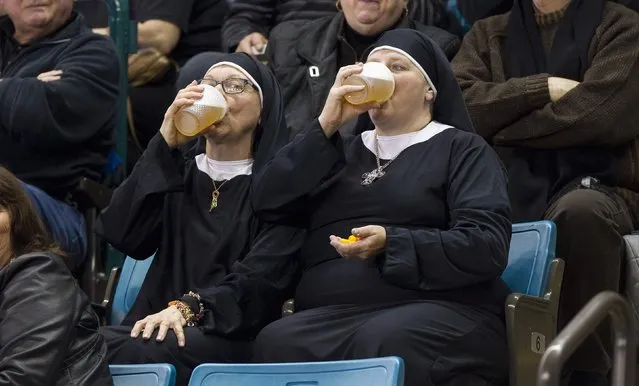
Two women wearing nun outfits drink beer while watching the 2014 Tim Hortons Brier curling championships in Kamloops, British Columbia in this March 8, 2014 file photo. Although some people might conclude that a curling event could produce a dull atmosphere, it is actually far from it. Some of the most energetic and loyal fans are committed to showing their colours at tournaments around the world. There was a lull in the games that were being held on this day and I remember spotting these nuns sitting in their seats earlier. Although them just sitting there didn't produce a picture, I kept my eye on them for the entire match. As soon as I spotted them with beer in their hands, I slowly turned my camera towards them and waited for them to take a drink. One of the challenges of shooting this image was to not have everyone notice me taking the photo. I had a longer lens on and was right in the middle of the rink. I slowly turned my lens, not to make my intentions too obvious, and waited until they drank from their beers together. (Photo and caption by Ben Nelms/Reuters)
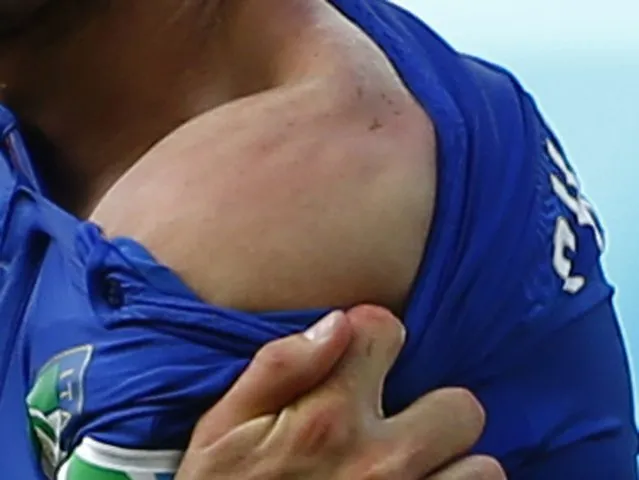
Italy's Giorgio Chiellini shows teeth marks on his shoulder where he was bitten by Uruguay's Luis Suarez, during their 2014 World Cup match at the Dunas arena in Natal in this June 24, 2014 file photo. I was covering Italy v. Uruguay and it felt almost just like any other match. But in the second half, there was some strange contact between Italy's Giorgio Chiellini and Uruguay's Luis Suarez. I was following the action elsewhere on the pitch, but I saw them both fall down. They both looked like they were in pain, and I started to take pictures until Chiellini reacted angrily right in front of me, pulling down his shirt to reveal his shoulder. I shot some photos and, for me, the story was finished. But I only did part of the work. The second, very important part of the job was done by our great editors who spotted the teeth marks on Chiellini's shoulder, and a cropped version of my picture was sent out to our clients so they could see too. (Photo and caption by Tony Gentile/Reuters)
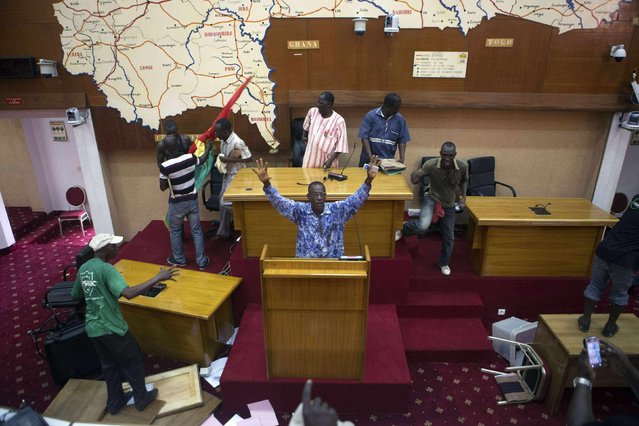
Anti-government protesters take over the parliament building in Ouagadougou, capital of Burkina Faso, in this October 30, 2014 file photo. I'd been following the protesters since the morning. Parliament was set to vote on a law extending the current president's 27-year term and the people were protesting against that. By the time it reached 9 a.m., tens of thousands had marched to the national assembly and physically stopped the vote from taking place. That's when I shot the picture – right at the beginning when the vote was supposed to be held. Inside parliament there was an atmosphere of pure ecstasy. I'm not sure the protesters themselves believed they had made it. Some might look at the images and say “These are unruly people, they're destroying public buildings”. But the protesters felt they were destroying public buildings that no longer represented the public. They felt they were taking matters into their own hands. (Photo and caption by Joe Penney/Reuters)
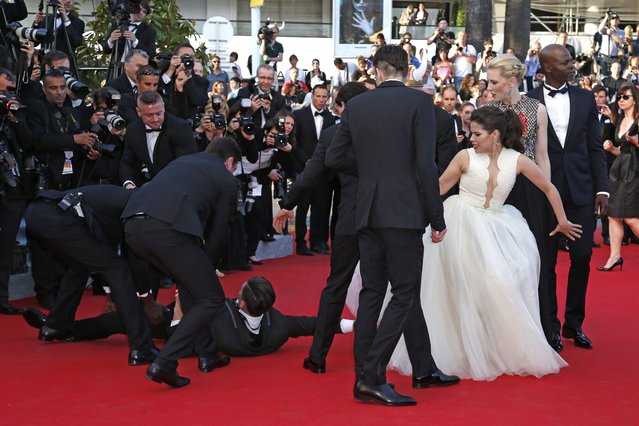
A man is arrested by security as he tries to slip under the dress of actress America Ferrera (3rd R) in Cannes in this May 16, 2014 file photo. I was covering the stars' red-carpet arrival for the film screening of “How to Train Your Dragon 2”. Suddenly Vitalii Sediuk, a Ukrainian journalist also known as a red-carpet prankster, tried to stick his head under actress America Ferrera's netted skirt. No doubt feeling fabulous in her beautiful couture gown, the moment was clearly ruined for Ferrera. I had only ten seconds to realise what was happening and take the shot. Security rapidly dealt with the culprit amid shocked looks from Ferrera and co-star Cate Blanchett. After a flash of appearing red faced and confused, the actress continued the red carpet walk as if nothing had happened. (Photo and caption by Benoit Tessier/Reuters)
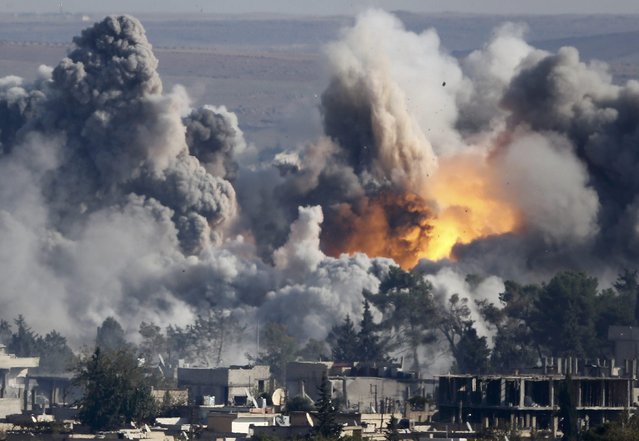
Smoke rises over Syrian town of Kobani after an airstrike, as seen from the Mursitpinar border crossing on the Turkish-Syrian border in the town of Suruc in this file October 18, 2014 file photo. A U.S.-led military coalition has been bombing Islamic State fighters who hold a large swathe of territory in both Iraq and Syria, two countries involved in complex multi-sided civil wars in which nearly every country in the Middle East has a stake. The Turkish military and police had declared the Turkish-Syrian border area a “military zone”, which limits the ability of the press to move around. In these days of modern warfare, the weaponry is more powerful than that in the old days. So all of my colleagues and I have to be doubly careful to ensure we do not end up in the line of fire, as positions of Kurdish YPG fighters and IS militants change quickly. For all those reasons, to stay away is the only solution at the moment. We ended up on hills about 2km (1.24 miles) away from Kobani using very long telephoto lenses, often more than 1000mm, to get a peek into the city while listening to the sound of war and smelling its scent. Sometimes you see a shadow of a fighter hiding behind a building and more often you see the massive impact of heavy airstrikes. It is a bit strange sitting there with lenses I usually use for sports photography alongside people from the area, who come to the hills to see what's going on. They bring binoculars and make tea – making it almost seems like a tourist attraction. (Photo and caption by Kai Pfaffenbach/Reuters)
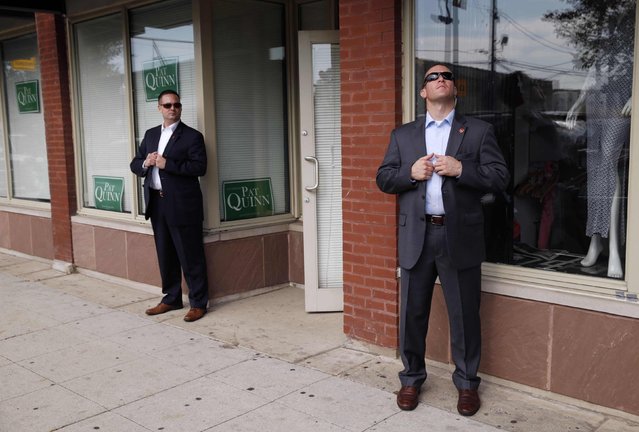
Secret Service agents keep watch as U.S. President Barack Obama visits a Pat Quinn campaign office in Chicago in this October 20, 2014 file photo. Two agents were posted outside this generic campaign office, and the simplicity of the setting and placement of the agents caught my eye. I took about 10 frames, and then one agent looked up. The juxtaposition of the agents was visually interesting and unique to me. For White House news photographers, a lot of what we do is orchestrated in advance. “Different” images can be few and far between. To capture a photo that is not preconceived or influenced by the political image makers is quite satisfying. Taking these photos is one of the greatest challenges in this kind of work. At the end of the day, the job of a Secret Service Presidential Protective Detail agent and a White House press travel pool photographer are not all that different. We go everywhere the President goes, we are ready to react to anything that might happen to the President, we think on our feet, we spend lots of hours waiting, we spend a lot of time on the road, we work strange hours and we are very close with our colleagues. Of course there some major differences. While we watch the President the agents scan the crowd. We carry cameras and they carry guns. Oh, they also tend to look a whole lot sharper than we do....those suits, haircuts and sunglasses do not come cheap. (Photo and caption by Kevin Lamarque/Reuters)
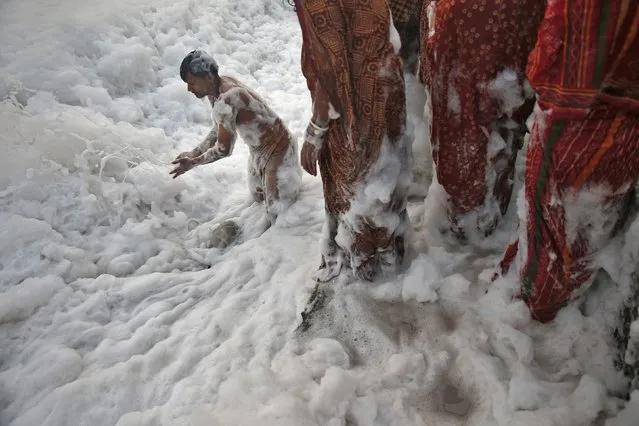
A Hindu devotee worships in the polluted waters of the river Yamuna during the Hindu religious festival of Chatt Puja in New Delhi in this October 30, 2014 file photo. I enjoy photographing religious events, especially those which involve late evening and early morning shoots. Chatt Puja is a Hindu festival worshipping the Sun God Surya, and thousands of people come and go throughout the day. Upon searching for images to shoot I came across a portion of the river where the foam had gathered in large amounts. I saw the men trying to push back the layer of foam on top of the water to make enough space for the women to stand in order to complete the rituals before sunrise. It was quite a struggle, men against foam. It looks like soap or a mountain of snow but actually it's all pollutants from sewage waters flowing into the Yamuna river. I started shooting women praying but had one eye on the men working their way through the foam. Once they spotted the sun which took longer due the fog in the air the man in the picture was at his best. I had a minute and thankfully some clean space to frame it. (Photo and caption by Ahmad Masood/Reuters)
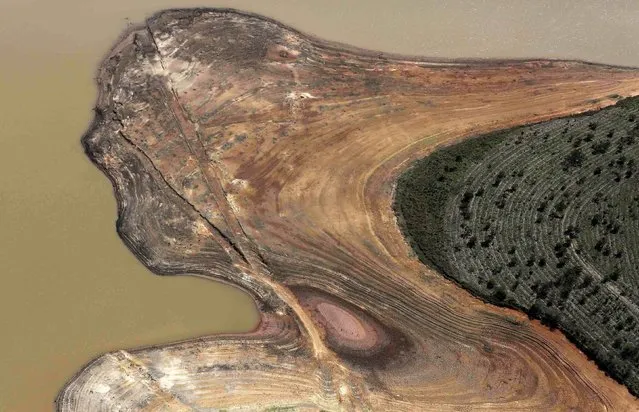
An aerial view of the Atibainha dam, part of the Cantareira reservoir, during a drought in Nazare Paulista, Sao Paulo state in this November 18, 2014 file picture. Words can't express what it feels like to view a landscape as bleak and disturbing as the one in this photo. In the four years I've lived in Brazil I've seen many extraordinary and terrifying things, but the current drought surrounding Sao Paulo for the past nine months surpasses all. Without rain, the reservoirs that provide South America's largest city with water are at their lowest level in decades. The World Cup and recent elections managed to distract the attention of the population away from the looming problem. They also seem to have kept the state's institutions busy with little attention paid to this pending disaster. As I rode in the helicopter to take this and other aerial photos, it was only after landing and opening the image on a computer that I noticed the real message that of a woman in panic as in Edvard Munch's painting “The Scream”. For me, this is Mother Nature screaming for help. (Photo and caption by Nacho Doce/Reuters)
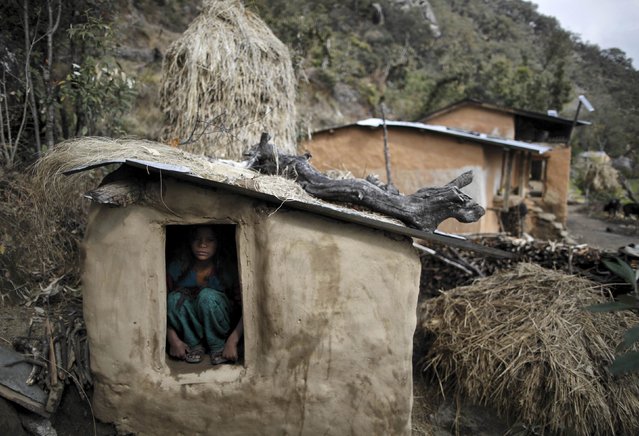
Uttara Saud, 14, sits inside a Chaupadi shed in the hills of Legudsen village in Achham District in western Nepal in this February 16, 2014 file picture. Chaupadi is the practice of treating women as impure and untouchable when they menstruate. In isolated regions like Achham, chaupadi has been a custom for centuries. But those from Nepal's cities or from abroad often don't know what it means. When women go through their monthly cycle, they are not allowed to enter a house or pass by a temple. They cannot use public water sources, touch livestock, attend social events like weddings, or touch others. And at night, they are not allowed to sleep in their homes – instead they have to stay in sheds or outbuildings, often with no proper windows or doors. As I worked on this story, I met many women who had been affected by the tradition. Uttara Saud, a shy 14-year-old girl, told me that she has to miss school during her monthly cycle. I realized that chaupadi does not just bring discomfort and isolation to the women practicing it – sometimes they even have to pay with their lives. Isolated and poorly protected from the elements, they can be killed by snake bites, freezing weather, wild animal attacks, or fires they light to keep warm, which can cause blazes or suffocation in small sheds with poor ventilation. There have also been cases of these women, cut off from their families, being the victims of rape. (Photo and caption by Navesh Chitrakar/Reuters)
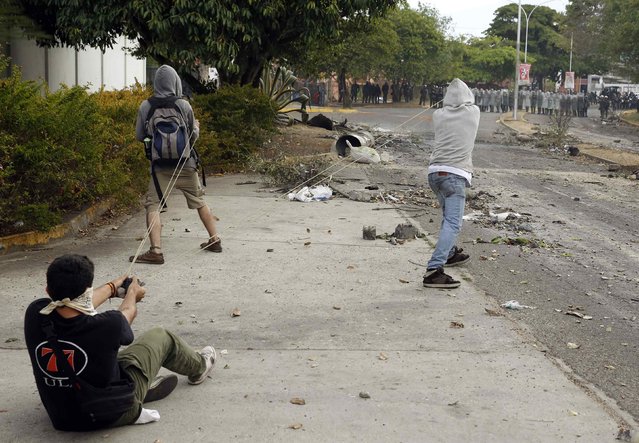
Demonstrators use a slingshot against the National Guard during a protest in San Cristobal, in this February 27, 2014 file photo. Following a couple of days of riots in Caracas, we decided to travel to the Venezuelan city of San Cristobal to photograph the conflict there. In the afternoon, I was told of clashes between anti-government protests and the National Guard, but barricades blocking almost every street made it extremely difficult to commute from one place to another, even by motorbike. When I finally arrived, it looked like the worst had passed as there was debris everywhere, but a group of youths with giant slingshots remained. With the help of their neighbours, who hurled objects from the top floors of buildings, they had driven the National Guard back to the end of the street. (Photo and caption by Carlos Garcia Rawlins/Reuters)
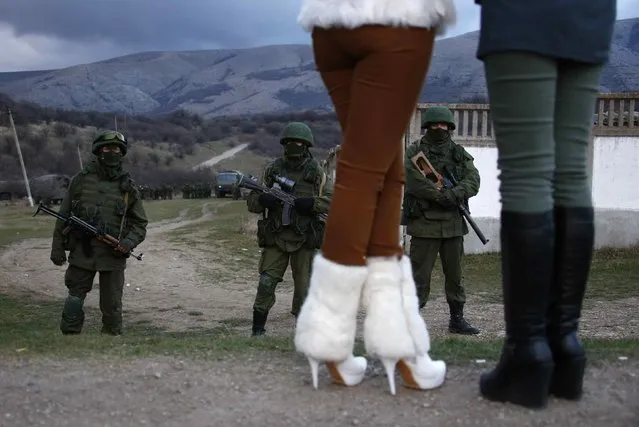
Local women watch armed men, believed to be Russian soldiers, assemble near a Ukrainian military base in Perevalnoe in this March 5, 2014 file photo. During Russia's occupation of the Crimean peninsular in Ukraine, masked men without insignia had appeared at Ukrainian army bases and important transport hubs all over the peninsular. Although they declined to say who they were, their Russian accents, military kit and license plates left little doubt that Moscow had sent them. The locals believed they would protect them from attackers from Kiev and consequently welcomed the Russian soldiers like liberators, bringing them flowers and food and flocking to wherever they set up base as if a travelling circus had come to town. These two women had clearly dressed up for the occasion and flirted with the young men in uniform, who were visibly grateful for the distraction to their sentry duty. Eventually, Russian soldiers became less anxious to be seen by foreign media chatting with their Ukrainian counterparts across the compound walls. (Photo and caption by Thomas Peter/Reuters)
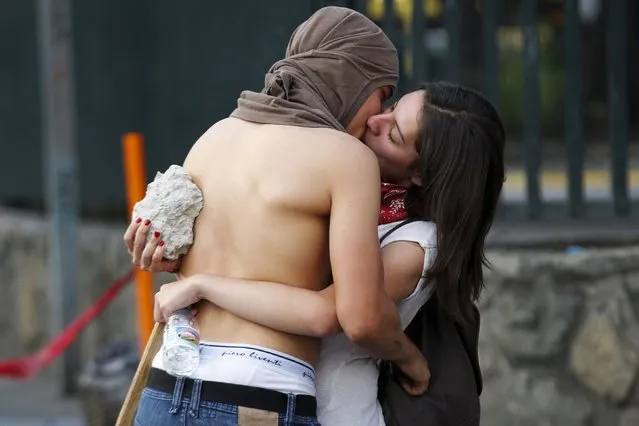
Anti-government protesters kiss during a protest against Venezuela's President Nicolas Maduro's government in Caracas in this March 22, 2014 file photo. I was covering a Caracas rally against Nicolas Maduro's government. Students were setting up a blockade and several had been arrested. They were organizing their counter-attack against the police when this girl, ironically the daughter of a government employee, suddenly appeared with a stone in her hand. I pointed my camera towards her as she walked up to her boyfriend and kissed him intensely in the midst of disaster. The challenge and the biggest reward of this picture was capturing something different to the tear bombs and shooting, an intimate and personal moment in the middle of chaos, something with soul and heart. The moment I took it, I knew this photo had something special, but I didn't realise the image's power until next day, when it went viral on social media. The photo is inspiring. Love is everywhere. (Photo and caption by Christian Veron/Reuters)
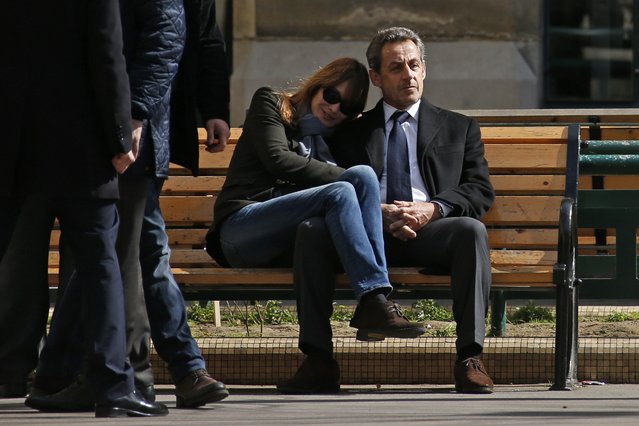
Former French President Nicolas Sarkozy sits on a bench with his wife Carla Bruni-Sarkozy in Paris, in this March 23, 2014 file photo. I was covering the first round of the French municipal elections in Paris and went to a local poll station in a school where Nicolas Sarkozy and Carla Bruni-Sarkozy were due to cast their votes. Afterwards they exited through the courtyard to avoid the crowds outside and realising the door was shut, sat together on a bench while waiting for the concierge to fetch the key. I had stayed behind in a school corridor to send out the photos I had just taken when I spotted the open door. I got inside the courtyard where there were two other photographers. Nicolas Sarkozy and Carla saw us, so I got only around 15 seconds to take their picture before their security staff stood in front of them. (Photo and caption by Benoit Tessier/Reuters)
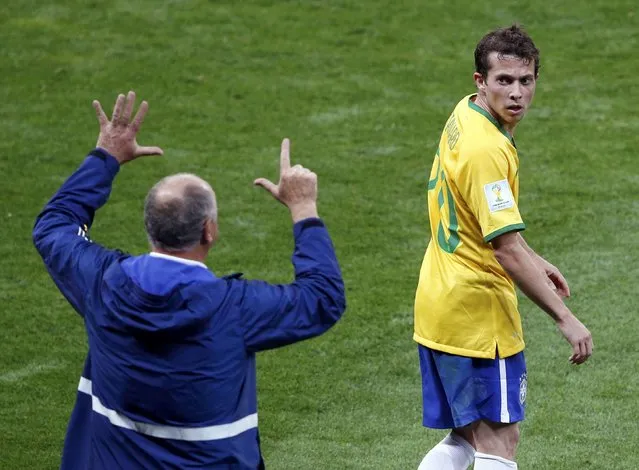
Brazil's coach Luiz Felipe Scolari (L) gestures to Bernard during their 2014 World Cup semi-finals against Germany at the Mineirao stadium in Belo Horizonte in this July 8, 2014 file photo. After Germany had scored an amazing six goals to none from Brazil, I thought I should start keeping an eye on Brazil's coach Luiz Felipe Scolari as he would certainly receive some harsh criticism after the game for his team's dramatic loss. He is always very animated during a game, and this moment occurred as he was yelling to a player to come off the field. The number he was yelling ended up being extremely symbolic, as Germany went on to defeat Brazil by 7 goals. I had a split-second to capture this moment. (Photo and caption by David Gray/Reuters)
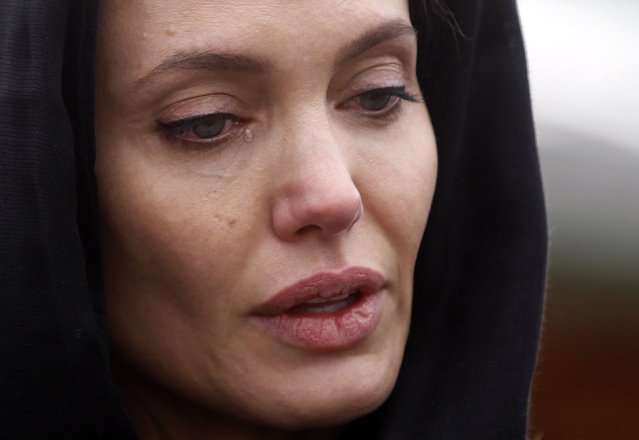
Actress Angelina Jolie cries at the Srebrenica Genocide Memorial in Potocari in this March 28, 2014 file photo. I was covering Angelina Jolie's visit to the Srebrenica Genocide Memorial and Cemetery, commemorating the brutal murder of 8,000 people in 1995, when she started to cry. Afterwards, she was due to visit rape victims' homes in the town of Zenica, so many photographers fled to the entrance to capture her departure. But I stayed on the floor, shooting, and was one of the lucky few to see her tears. Capturing this image was a challenge as there was a lot of travelling involved for very few photographs. The weather was hot, there was a lack of organisation and I was often bothered by colleagues. But this image had a great impact when the whole world wrote about her visit to Bosnia, this photograph was especially powerful because of her tears. Angelina's tears and the photos I took meant a lot to me. I was happy because the whole world will hear about what happened in Srebrenica. But I was also sad, because of the reason for her arrival and because Srebrenica was mentioned solely in the context of war. (Photo and caption by Dado Ruvic/Reuters)
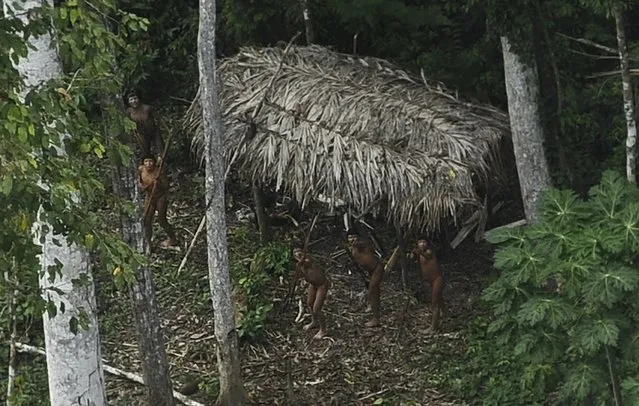
Indians who are considered uncontacted by anthropologists react to a plane flying over their community in the Amazon basin near the Xinane river in Brazil's Acre State, near the border with Peru, in this March 25, 2014 file photo. I was flying over the Amazon alongside an Ashaninka chief who was searching for illegal logging on their lands. It was a bad flight. Grey skies and heavy winds, over a sea of unbroken forest – no sign of humanity all the way to the horizon. Suddenly, down below us, we saw a spot of clearing and this group of isolated Indians. The way they raised their spears and bows against us, it felt like I was witnessing the last line of human resistance against the world the rest of us have made. Three months after this photo was published, the same group of Indians made their first formal contact with the Ashaninka people and Brazil's national Indian agency (Funai). They said encroaching non-Indians had burned their villages – which lie in a border region with known drug trafficking and illegal logging activity. Immediately after meeting the outsiders, several of the Indians fell ill. Funai says the situation is under control: It provided flu shots and has reopened a local base that it abandoned three years earlier, following an attack by cartel gunmen. (Photo and caption by Lunae Parracho/Reuters)
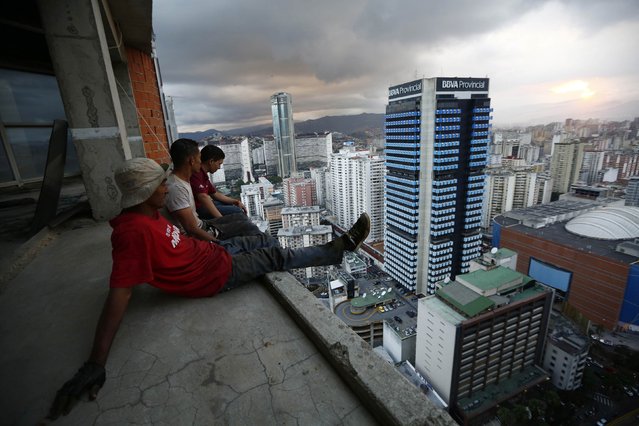
Men rest after salvaging metal on the 30th floor of the “Tower of David” skyscraper in Caracas in this February 3, 2014 file photo. The building was intended to be a shining new financial center but was abandoned around 1994 after the death of its developer and the collapse of the financial sector. Squatters invaded the huge concrete skeleton in 2007 and now about 3,000 people call the tower their home. The first time I tried to get access to the tower wasn't really a success. I was told, not in the friendliest of terms, that I should leave while I still could. The residents of the tower, and particularly those in charge of managing it, were (and still are) very sensitive to media. Publications frequently feature headlines such as: “Tower of terror”, “The shanty skyscraper”, it has even been featured in an episode of the TV series “Homeland” as a kidnappers' den. My intention wasn't to follow on from these headlines. I wanted above all to create a portrait of the lives of the thousands of people who call this place home, and who face struggles and risks every day. I wanted to document without judging. That is what I told the squatters' board of administrators, who made me explain my intentions in producing this story. I felt the strong sense of community here from the first time I ascended the tower. (Photo and caption by Jorge Silva/Reuters)
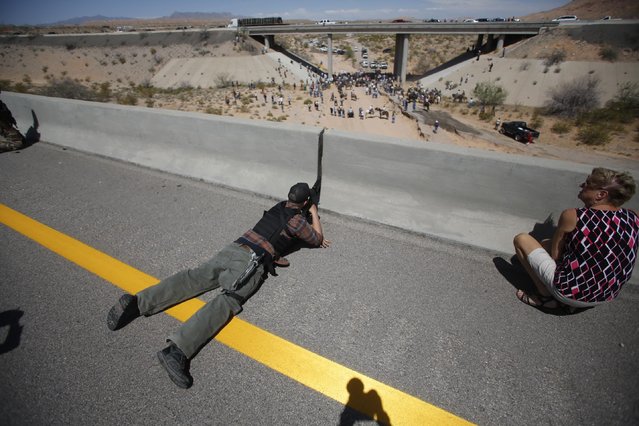
Eric Parker from central Idaho aims his weapon from a bridge as protesters gather by the Bureau of Land Management's (BLM) base camp, where cattle that were seized from rancher Cliven Bundy are being held, near Bunkerville, Nevada in this April 12, 2014 file photo. We were on a bridge in southern Nevada in the midst of a tense standoff between the BLM and a group of angry ranchers, militia members and gun-rights activists. It seemed as if we were a hair's breadth away from Americans killing Americans right in front of me. This showdown had come after the BLM started rounding up cattle belonging to rancher Cliven Bundy, who had been letting his animals graze illegally on federal land for over 20 years. I found myself in the photographer's typical position when covering standoffs – behind law enforcement. But just as I started feeling comfortable with my surroundings, a woman yelled out that there was an incident taking place below the bridge a couple hundred meters to the east, and I began sprinting that way with other members of the media. The weight of my camera gear slowed me down but I told myself I needed to keep running. I had to be at the scene as fast as possible. It was already a surreal moment, here on a random stretch of highway in the Nevada desert, where men with weapons had taken up tactical positions on government officers something not seen in this country in decades as traffic whizzed by unaware. Sometimes cars would stop and people would step out to take pictures of the scene with their phones, as if it were just another roadside attraction. After a while it became apparent that the BLM was going to release the cattle to the protesters. The animals were freed, and no shots were fired. But the reality of how close to gunfire the situation had come sent a chill through me which I will never forget. (Photo and caption by Jim Urquhart/Reuters)
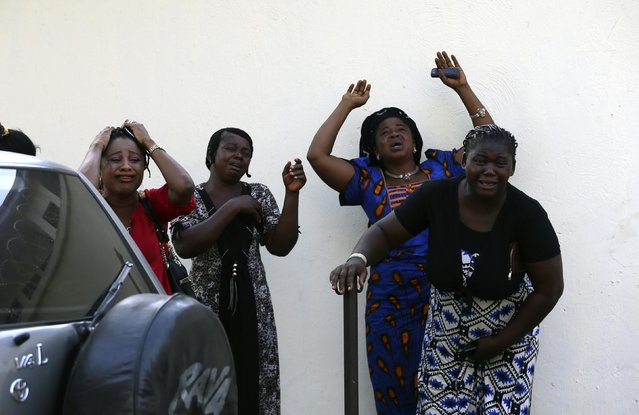
Bystanders react as victims of a bomb blast arrive at the Asokoro General Hospital in Abuja in this April 14, 2014 file photo. A morning rush-hour bomb killed at least 71 people at a Nigerian bus station near the capital. I had just shot the wedding of the president's daughter in Abuja and was looking forward to a quiet week. On my way home I was listening to the radio and then came the announcement of an explosion in the busy Nyanya suburb. My heart flashed with panic and anxiety, and I decided to go to the nearest hospital. Gaining access to the premises was a challenge but after a lot of pleading I managed to persuade security to let me in. The sight was unbearable, and the smell of burnt skin filled the air. The crowd gathered at the hospital was overtaken with emotion and pandemonium ensued. As I was shooting away, there came another siren from the gate. I turned and noticed these women standing by the wall, close to the morgue, breaking down in tears and calling on God to help put an end to senseless killings. I turned my camera towards the women and tried to compose the shot carefully, but from my position the vehicle behind which the women were standing was intruding into the frame. There was no way to quickly relocate and recompose the shot, as I did not want to interfere with what was going on. (Photo and caption by Afolabi Sotunde/Reuters)
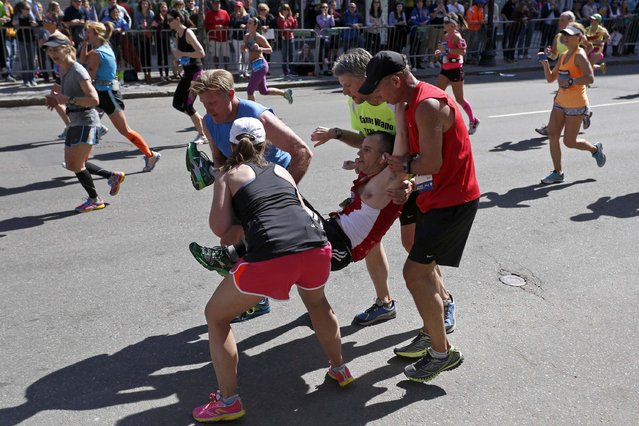
Four runners carry Adam Hurst down Boylston Street after his legs locked up during the 118th running of the Boston Marathon in Boston, Massachusetts in this April 21, 2014 file photo. I was positioned near the Forum restaurant in case anything significant happened at the time and place of last year's second bomb attack. I heard the crowd starting to make noise and noticed a man struggling but still standing, legs locked after just having passed 26 miles. The cheers from the sidelines were louder than anything I had heard all day, urging him on, but his body wouldn't cooperate. That's when a man, I think David Meyer, stopped his run and offered help. Four runners decided to each take one of Hurst's limbs and haul him closer to the line. The moment Hurst's feet came off the ground the spectators erupted in a cheer and they set off faster than I was able to keep up with them on the sidewalk. Both as a journalist and a runner it mattered to me whether he finished on his own legs or theirs, but most importantly I knew it mattered to Hurst. The last thing I wanted was for him to see my picture published saying he didn't carry himself over that line. Some folks have pointed out that this sort of moment is almost commonplace in marathons, and that's partly true. But just because what happened that day on Boylston Street isn't unprecedented doesn't mean it isn't special. The moment I was fortunate to witness sums up so much of what I love about this city, this sport, and this event in particular. (Photo and caption by Dominick Reuter/Reuters)
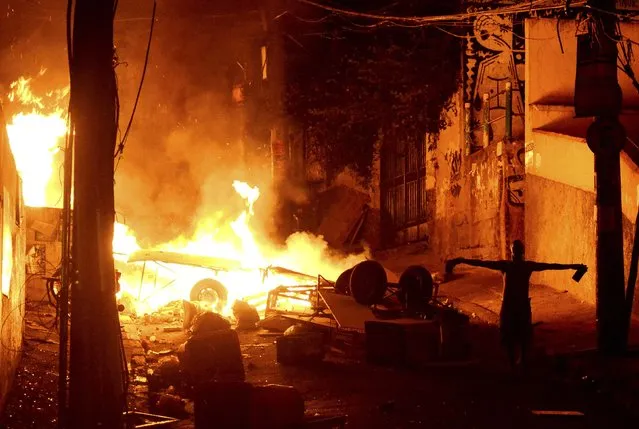
A resident gestures during a protest against the death of a man in Pavao-Pavaozinho slum, in Rio de Janeiro in this April 22, 2014 file photo. Residents accused Police Peacekeeping Unit (UPP) officers of causing the death of a dancer, Douglas Rafael da Silva Pereira, 25, who was found dead inside a school at the community. When the shooting began I was at home. The favela is just round the corner, so I saw the police cars in the streets, fire in the slum and the street gradually emptying. When I arrived at the slum the residents were in one corner and the police in another. Both screaming and very tense. The residents had set fire to the entrance of the slum, to stop the police getting in. But the police had guns pointed at them all the time. That's why the man in the picture is opening his arms, to show the police that he is “clean”. After that, the residents left the body, covered in blood, in the middle of the street and the police went in to get the dead man. I was the only one that took these pictures, because I was the first photographer to get there. (Photo and caption by Lucas Landau/Reuters)
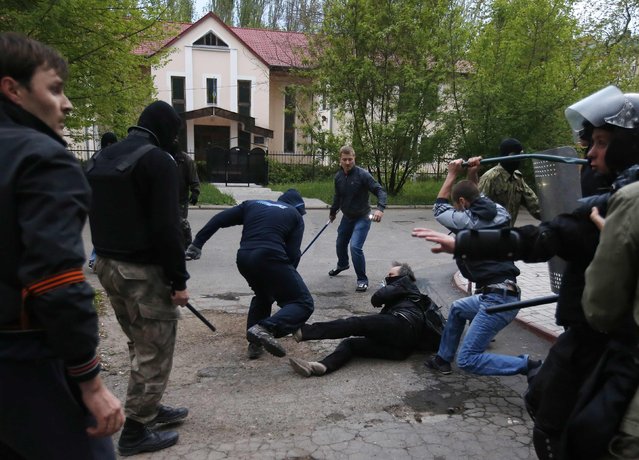
Pro-Russian protesters attack a pro-Ukranian protester during a pro-Ukrainian rally in the eastern city of Donetsk in this April 28, 2014 file photo. Around 500 people were waving Ukrainian flags and shouting anti-Russian slogans. After 30 minutes they started a protest march, but soon afterwards pro-Russian protesters turned up with baseball bats and sticks and clashes broke out. I followed pro-Ukrainians who ran away to small alley, but as there was no way out they got trapped. After some 30 seconds, pro-Russians came and started beating them. For me the image was important because it shows how easily people who were living together for years can turn violent overnight because of politics. Moments before I took this picture I remember I was hiding behind a tree because stones from both sides were flying around. I remember one stone hit Baz Ratner, our photographer who was covering the event with me. The biggest challenge while shooting this image was to not get beaten, because people were extremely violent and they didn't care if you were a journalist. (Photo and caption by Marko Djurica/Reuters)
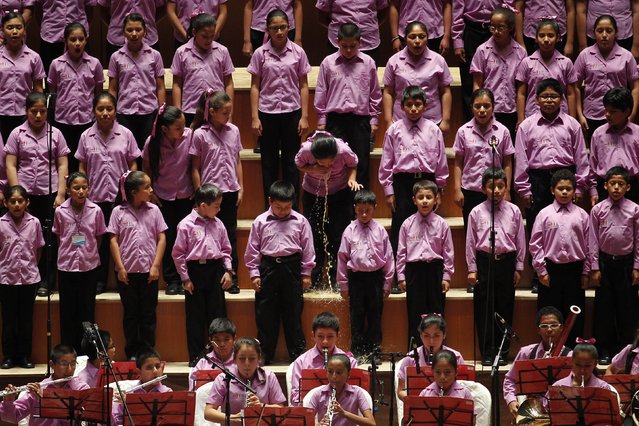
A young member of the choir of “Sinfonia por el Peru” vomits before performing with Peruvian tenor Juan Diego Florez at Lima's National Theatre, in this May 13, 2014 file photo. I was covering a concert at Lima's National Theatre, awaiting the appearance of Peruvian tenor Juan Diego Florez, who was singing with the young members of the orchestra he was sponsoring, “Sinfonia por el Peru”. Moments before he showed up, a choir girl in the middle started vomiting. The children were performing for a very refined audience that came to see Florez, and perhaps she couldn't handle it. When she threw up for a second time, her vomit splashed onto the kids around her. They were all very professional and continued performing until eventually she was told to step off the stage. (Photo and caption by Enrique Castro-Mendivil/Reuters)
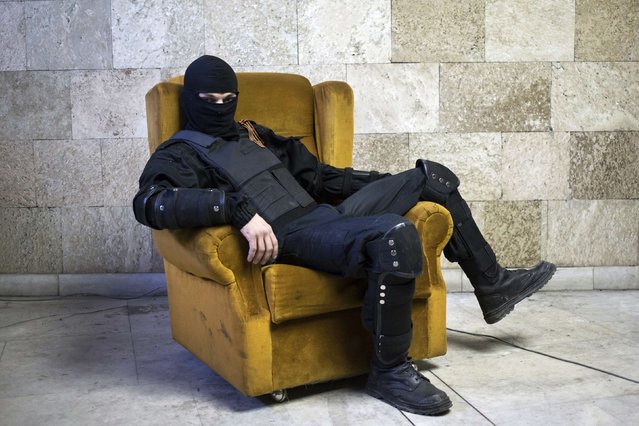
A masked pro-Russian protester sits on a chair as he poses for a picture inside a regional government building in Donetsk, eastern Ukraine in this April 25, 2014 file photo. On March 3, a couple hundred pro-Russian demonstrators stormed the Donetsk regional government building after clashing with police who were guarding the main entrance. They successfully entered through a side door, and in the end made it to the second floor where the parliament sits. Unrest continued to spiral in Ukraine and the following month separatists declared a “People's Republic of Donetsk”. Two months after these initial attacks, protestors were still inside the regional government buildings and masked men guarded the barricades. I asked to take a series of portraits of these men. I saw a massive chair underneath a neon light and I picked my lens, adjusted the light, and people began to pose in shifts. Each subject was relaxed, and struck whatever pose suited him. Later, they asked with interest how people in Europe see the situation in Ukraine and wanted to know if anyone supports them, and what will happen in the end. They seemed a bit scared. I didn't have a good answer to their last question. (Photo and caption by Marko Djurica/Reuters)
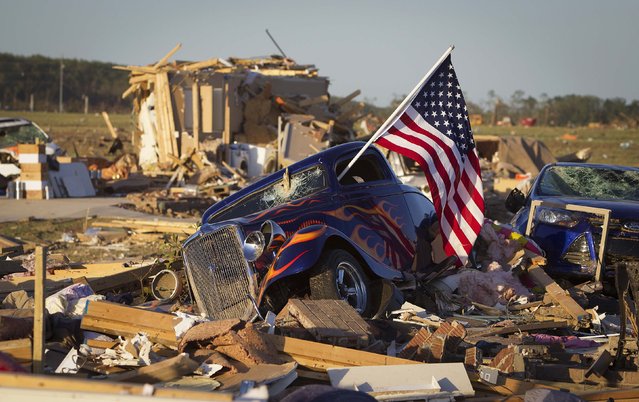
A U.S. flag sticks out the window of a damaged hot rod car in a suburban area after a tornado near Vilonia, Arkansas in this April 28, 2014 file photo. I was covering the tornados that swept though Arkansas and other states killing 35 people and I decided to drive out to Vilona, an area that had suffered some of the worst damage, having seen it from a plane. Gaining access into the area was difficult and I arrived quite late in the day so most of the rescue efforts had ceased, but I felt it was an important story to tell. I was walking around when I noticed the vintage hot-rod on a pile of rubble that had been a house, and I thought it was a good image to demonstrate American resilience and courage in the face of such a disaster. I had to crawl over the debris so I could get a photo of the front of the car with the flag out the window and some of the other houses in the background that had been destroyed. I was affected by the image's story when I found out that the owner of the car and house, Dan Wasson, died in the tornado as he huddled over his wife and daughters in their home. (Photo and caption by Carlo Allegri/Reuters)
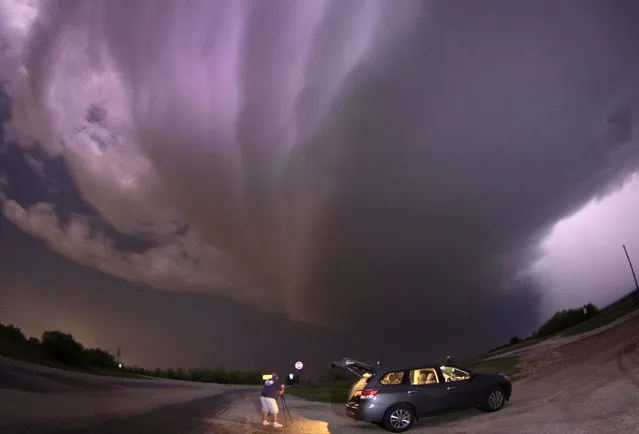
A large TVS (tornadic vortex signature) thunderstorm supercell passes over storm chaser Brad Mack in Graham, Texas late in this April 23, 2014 file picture. I was covering the Tornado and Dixie Alleys, areas of the central and southern United States which are vulnerable to strong tornados, due to the severe weather forecast for that week. We had been chasing the storm for almost 18 hours when I saw this tornadic cell coming at us at about 45-50 miles per hour. With very little time, I had to quickly switch to a wider lens to capture the storm coming over us. The image shows just how big these cells are and how close we had to get to create the image. I had one chance to get the shot and I'm just happy I was able to switch lenses in time. (Photo and caption by Gene Blevins/Reuters)
27 Nov 2014 14:39:00,
post received
0 comments
